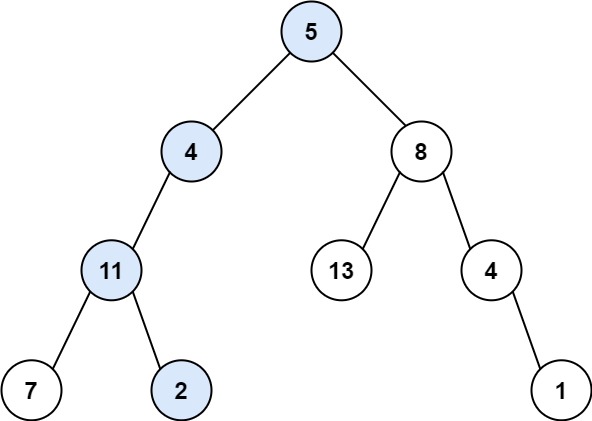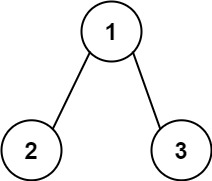112. Path Sum
Description
Given the root of a binary tree and an integer targetSum, return true if the tree has a root-to-leaf path such that adding up all the values along the path equals targetSum.
A leaf is a node with no children.
Example 1:

- Input: root = [5,4,8,11,null,13,4,7,2,null,null,null,1], targetSum = 22
- Output: true
- Explanation: The root-to-leaf path with the target sum is shown.
Example 2:

- Input: root = [1,2,3], targetSum = 5
- Output: false
- Explanation: There are two root-to-leaf paths in the tree:
(1 –> 2): The sum is 3.
(1 –> 3): The sum is 4.
There is no root-to-leaf path with sum = 5.
Example 3:
- Input: root = [], targetSum = 0
- Output: false
- Explanation: Since the tree is empty, there are no root-to-leaf paths.
Constraints:
- The number of nodes in the tree is in the range [0, 5000].
- -1000 <= Node.val <= 1000
- -1000 <= targetSum <= 1000
Submitted Code
# Definition for a binary tree node.
# class TreeNode(object):
# def __init__(self, val=0, left=None, right=None):
# self.val = val
# self.left = left
# self.right = right
class Solution(object):
def hasPathSum(self, root, targetSum):
"""
:type root: Optional[TreeNode]
:type targetSum: int
:rtype: bool
"""
if not root:
return False
sum = 0
stack = [(0, root)]
while stack:
sum, node = stack.pop()
sum += node.val
if not node.left and not node.right: # 잎 노드에 도달
if sum == targetSum:
return True
if node.right: # 오른쪽, 왼쪽 순으로 스택에 추가
stack.append((sum, node.right))
if node.left:
stack.append((sum, node.left))
return False
Runtime: 0 ms | Beats 100.00%
Memory: 14.32 MB | Beats 25.81%
스택을 사용해서 실행 시간을 단축해봤다.
class Solution(object):
def hasPathSum(self, root, targetSum):
if not root:
return False
def count_sum(root, targetSum, sum):
if not root.left and not root.right:
return False if sum + root.val != targetSum else True
else:
l_tree = False if not root.left else count_sum(root.left, targetSum, sum+root.val)
r_tree = False if not root.right else count_sum(root.right, targetSum, sum+root.val)
if l_tree or r_tree:
return True
else:
return False
return count_sum(root, targetSum, 0)
재귀 호출을 이용한 방법은 거의 꼴지에 가까운 실행시간을 기록했다. 또 깊이 우선 탐색의 문제점을 알게 됐다.
왼쪽 서브트리나 오른쪽 서브트리의 결과 중 하나가 True이면 or 이기 때문에 True를 반환하는데, 파이썬에서는 더 앞에 위치하는 l_tree에서 True가 나올 경우 자동으로 뒤의 r_tree의 계산을 스킵하는 것 같다. 하지만 r_tree가 True여도 l_tree 계산은 무조건 하게 되기 때문에 어느 쪽 잎 노드가 정답인지에 따라 효율이 많이 달라질 수 있다.
Other Solutions
1st
class Solution:
def hasPathSum(self, root: Optional[TreeNode], targetSum: int) -> bool:
if not root:
return False
if not root.left and not root.right:
return targetSum == root.val
left_sum = self.hasPathSum(root.left, targetSum - root.val)
right_sum = self.hasPathSum(root.right, targetSum - root.val)
return left_sum or right_sum
time complexity: 𝑂(𝑛)
space complexity: 𝑂(ℎ)
따로 합을 계산하는 변수를 만들지 않고 targetSum에서 빼는 방식으로 공간을 절약한 예시였다.
2nd
from collections import deque
class Solution:
def hasPathSum(self, root: TreeNode, targetSum: int) -> bool:
if not root:
return False
queue = deque([(root, targetSum - root.val)])
while queue:
node, curr_sum = queue.popleft()
# Check if the current node is a leaf and its sum is zero
if not node.left and not node.right and curr_sum == 0:
return True
# Add left child to queue if exists
if node.left:
queue.append((node.left, curr_sum - node.left.val))
# Add right child to queue if exists
if node.right:
queue.append((node.right, curr_sum - node.right.val))
return False
큐를 사용하여 너비 우선 탐색을 하면 좌우 상관없이 균일한 실행시간을 가질 수 있다.
root = [5,4,8,11,null,13,4,7,2,null,null,null,1]
targetSum = 22
[5]
/ \
[4] 8
/ / \
[11] 13 4
/ \ \
7 [2] 1
queue node.val curr_sum
[(5, 22)] 5 17 (22 - 5)
[(4, 17), (8, 17)] 4 13 (17 - 4)
[(8, 17), (11, 13)] 11 2 (13 - 11)
[(8, 17), (7, 2), (2, 2)] 2 0 (2 - 2) → True
return True



Leave a comment